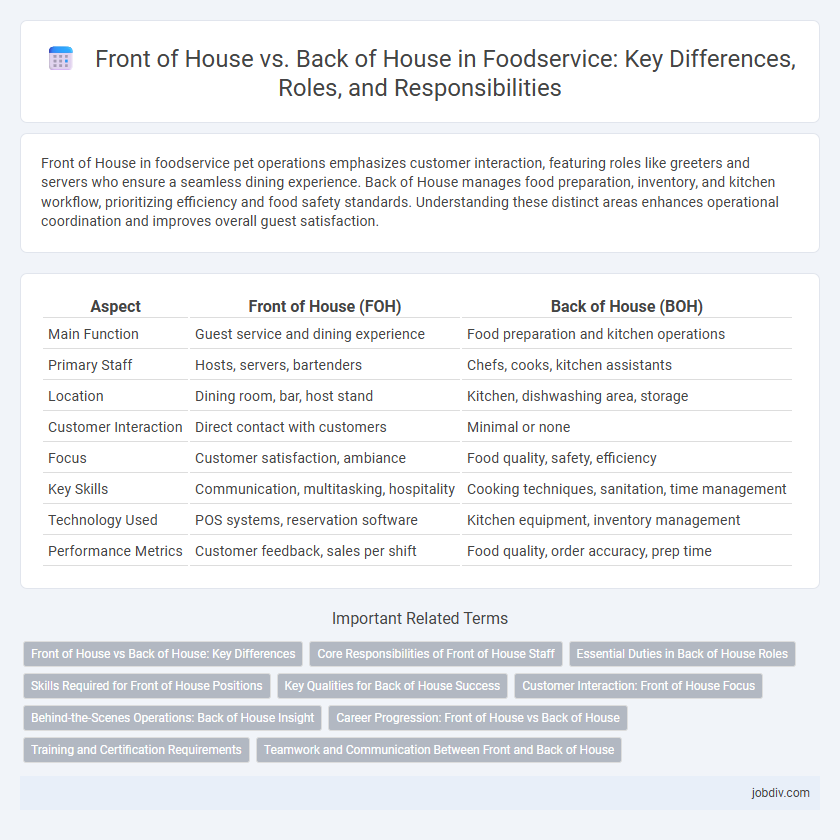Front of House in foodservice pet operations emphasizes customer interaction, featuring roles like greeters and servers who ensure a seamless dining experience. Back of House manages food preparation, inventory, and kitchen workflow, prioritizing efficiency and food safety standards. Understanding these distinct areas enhances operational coordination and improves overall guest satisfaction.
Table of Comparison
| Aspect | Front of House (FOH) | Back of House (BOH) |
|---|---|---|
| Main Function | Guest service and dining experience | Food preparation and kitchen operations |
| Primary Staff | Hosts, servers, bartenders | Chefs, cooks, kitchen assistants |
| Location | Dining room, bar, host stand | Kitchen, dishwashing area, storage |
| Customer Interaction | Direct contact with customers | Minimal or none |
| Focus | Customer satisfaction, ambiance | Food quality, safety, efficiency |
| Key Skills | Communication, multitasking, hospitality | Cooking techniques, sanitation, time management |
| Technology Used | POS systems, reservation software | Kitchen equipment, inventory management |
| Performance Metrics | Customer feedback, sales per shift | Food quality, order accuracy, prep time |
Front of House vs Back of House: Key Differences
Front of House (FOH) in foodservice encompasses customer-facing roles such as hosts, servers, and bartenders, responsible for guest interaction and atmosphere management. Back of House (BOH) involves kitchen staff, including chefs and dishwashers, focusing on food preparation, cooking, and cleanliness. Key differences lie in the nature of tasks, with FOH prioritizing customer service and BOH emphasizing food quality and operational efficiency.
Core Responsibilities of Front of House Staff
Front of House staff in foodservice are primarily responsible for greeting and seating guests, managing reservations, and ensuring a positive dining experience. They handle customer service tasks such as taking orders, serving food and beverages, and addressing any guest concerns promptly. Efficient communication with Back of House teams is essential to maintain smooth operations and uphold high service standards.
Essential Duties in Back of House Roles
Back of House roles in foodservice primarily involve tasks like food preparation, cooking, and maintaining kitchen hygiene to ensure safe and efficient meal production. Essential duties include managing inventory, operating kitchen equipment, and adhering to health and safety regulations. These responsibilities directly impact food quality and timely service, supporting overall restaurant operations.
Skills Required for Front of House Positions
Front of House positions in foodservice demand strong interpersonal skills, excellent communication, and the ability to manage customer interactions smoothly. Proficiency in multitasking, problem-solving, and maintaining a positive attitude under pressure are essential for roles such as hosts, servers, and bartenders. Knowledge of POS systems, menu memorization, and teamwork further enhance efficiency and guest satisfaction in a fast-paced dining environment.
Key Qualities for Back of House Success
Back of House success in foodservice hinges on effective kitchen management, precise inventory control, and strong teamwork among chefs and cooks. Expertise in food safety protocols and efficient workflow design minimizes errors and optimizes meal preparation times. Mastery of equipment handling and adaptability to peak service demands also play critical roles in maintaining consistent kitchen performance.
Customer Interaction: Front of House Focus
Front of House staff directly engage with customers, managing seating, taking orders, and addressing inquiries to enhance the dining experience. Their role includes creating a welcoming atmosphere, ensuring prompt service, and handling special requests with professionalism. Effective customer interaction by Front of House employees is essential for building customer satisfaction and repeat business in foodservice establishments.
Behind-the-Scenes Operations: Back of House Insight
Back of House operations in foodservice encompass crucial activities such as food preparation, cooking, inventory management, and sanitation protocols that ensure seamless service delivery. Efficient coordination between kitchen staff and management optimizes workflow, reduces food waste, and maintains compliance with health regulations. Advanced back-of-house technologies like kitchen display systems and inventory software enhance order accuracy and operational efficiency, directly impacting customer satisfaction.
Career Progression: Front of House vs Back of House
Career progression in foodservice varies significantly between Front of House (FOH) and Back of House (BOH) roles, with FOH positions often leading to management roles like Floor Manager or Guest Experience Manager due to direct customer interaction and leadership opportunities. BOH career paths focus on culinary expertise and operational efficiency, advancing from line cook to sous chef and eventually executive chef or kitchen manager. Both tracks require strong communication, teamwork, and problem-solving skills but emphasize different areas of expertise aligned with customer service for FOH and food preparation for BOH.
Training and Certification Requirements
Front of House staff in foodservice require training in customer service, point-of-sale systems, and health safety protocols, often needing certifications like ServSafe Food Handler or Alcohol Server permits. Back of House personnel must undergo rigorous culinary training, including knife skills, cooking techniques, and food safety certifications, such as ServSafe Manager or HACCP certification. Both areas prioritize continuous education to ensure compliance with health regulations and enhance operational efficiency.
Teamwork and Communication Between Front and Back of House
Effective teamwork and clear communication between Front of House (FOH) and Back of House (BOH) are crucial for smooth foodservice operations, ensuring timely order delivery and enhanced customer experience. Immediate feedback loops and digital order management systems help synchronize efforts between servers and kitchen staff, minimizing errors and wait times. Consistent coordination boosts overall efficiency, customer satisfaction, and workplace morale within hospitality environments.
Front of House vs Back of House Infographic

 jobdiv.com
jobdiv.com